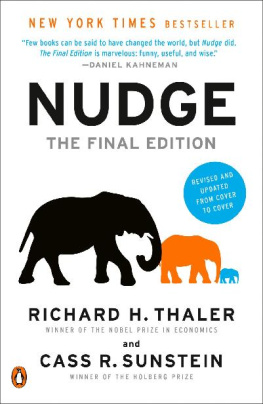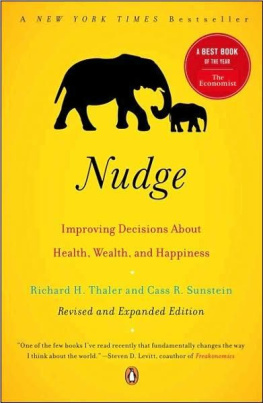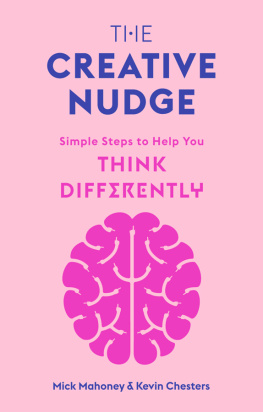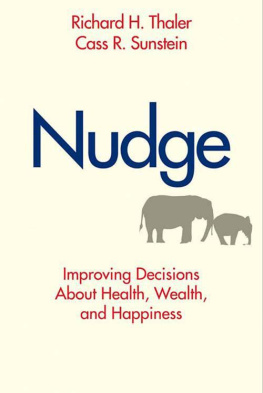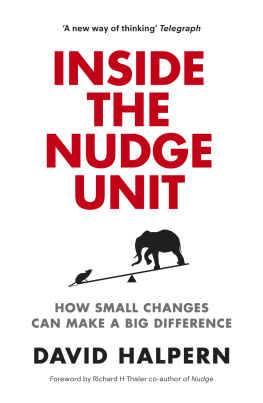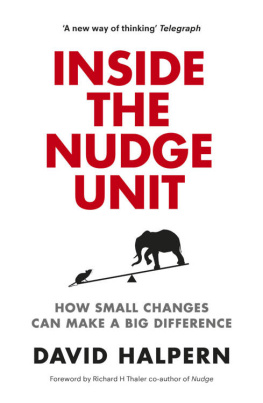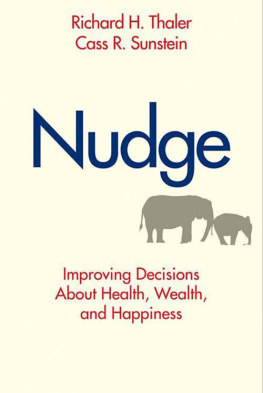NUDGE
NUDGE
Improving Decisions About
Health, Wealth, and Happiness
Richard H. Thaler
Cass R. Sunstein
Yale University Press
New Haven & London
A Caravan book. For more information, visit
www.caravanbooks.org.
Copyright 2008 by Richard H. Thaler and Cass R. Sunstein.
All rights reserved.
This book may not be reproduced, in whole or in part, including illustrations, in any form (beyond that copying permitted by Sections 107 and 108 of the U.S. Copyright Law and except by reviewers for the public press), without written permission from the publishers.
Set in Galliard and Copperplate 33 types by The Composing Room of Michigan, Inc.
Printed in the United States of America.
Library of Congress Cataloging-in-Publication Data
Thaler, Richard H., 1945
Nudge : improving decisions about health, wealth, and happiness / Richard H. Thaler and Cass R. Sunstein.
p. cm.
Includes bibliographical references and index.
ISBN 978-0-300-12223-7 (cloth : alk. paper) 1. Economics Psychological aspects. 2. Choice (Psychology)Economic aspects. 3. Decision makingPsychological aspects. 4. Consumer behavior. I. Sunstein, Cass R. II. Title.
HB74.P8T53 2008
330.019dc22
2007047528
A catalogue record for this book is available from the British Library.
The paper in this book meets the guidelines for permanence and durability of the Committee on Production Guidelines for Book Longevity of the Council on Library Resources.
10 9 8 7 6 5 4 3 2 1
For France, who makes everything in life better, even this book
RHT
For Ellyn, who knows when to nudge her father
CRS
CONTENTS
ACKNOWLEDGMENTS
The research for this book would not have been possible without financial support from the University of Chicago Graduate School of Business and Law School. We have also received generous support from the John Templeton Foundation through a grant to the Center for Decision Research.
Many people have helped us with this book. Sydelle Kramer, our agent, provided wonderful advice throughout. Michael OMalley, our editor, made valuable suggestions on the manuscript. Dan Heaton, our copy editor, cleaned up our writing with style and good humor. Special thanks to our fun and stellar team of research assistants, extending over two summers; they include John Balz (who gets double thanks for putting up with us for two summers), Rachael Dizard, Casey Fronk, Matthew Johnson, Heidi Liu, Brett Reynolds, Matthew Tokson, and Adam Wells. Kim Bartko was invaluable in helping us with the artwork in the book and with the cover design.
Many colleagues made the book a lot better. For insights, hints, and even a few nudges beyond the call of both friendship and duty, we single out Shlomo Benartzi, Elizabeth Emens, Nick Epley, Dan Gilbert, Tom Gilovich, Jonathan Guryan, Justine Hastings, Christine Jolls, Daniel Kahneman, Emir Kamenica, Dean Karlan, David Leonhardt, Michael Lewis, Brigitte Madrian, Cade Massey, Phil Maymin, Sendhil Mullainathan, Don Norman, Eric Posner, Richard Posner, Raghu Rajan, Dennis Regan, Tom Russell, Jesse Shapiro, Jennifer Tesher, Edna Ullmann-Margalit, Adrian Vermeule, Eric Wanner, Roman Weil, Susan Woodward, and Marion Wrobel. As always, our toughest and wisest advice came from France Leclerc and Martha Nussbaum. Vicki Drozd helped out with everything, as she always does, and made sure that all the research assistants got paid, which they appreciated. Thanks too to Ellyn Ruddick-Sunstein, for helpful discussion, patience, both sense and amusement about behavioral economics, and good cheer.
We also owe a special thanks to all the staff at Noodles restaurant on 57th Street. They have fed us and listened to us planning and discussing this book, among other things, for several years now. Well be back next week.
INTRODUCTION
The Cafeteria
A friend of yours, Carolyn, is the director of food services for a large city school system. She is in charge of hundreds of schools, and hundreds of thousands of kids eat in her cafeterias every day. Carolyn has formal training in nutrition (a masters degree from the state university), and she is a creative type who likes to think about things in nontraditional ways.
One evening, over a good bottle of wine, she and her friend Adam, a statistically oriented management consultant who has worked with supermarket chains, hatched an interesting idea. Without changing any menus, they would run some experiments in her schools to determine whether the way the food is displayed and arranged might influence the choices kids make. Carolyn gave the directors of dozens of school cafeterias specific instructions on how to display the food choices. In some schools the desserts were placed first, in others last, in still others in a separate line. The location of various food items was varied from one school to another. In some schools the French fries, but in others the carrot sticks, were at eye level.
From his experience in designing supermarket floor plans, Adam suspected that the results would be dramatic. He was right. Simply by rearranging the cafeteria, Carolyn was able to increase or decrease the consumption of many food items by as much as 25 percent. Carolyn learned a big lesson: school children, like adults, can be greatly influenced by small changes in the context. The influence can be exercised for better or for worse. For example, Carolyn knows that she can increase consumption of healthy foods and decrease consumption of unhealthy ones.
With hundreds of schools to work with, and a team of graduate student volunteers recruited to collect and analyze the data, Carolyn believes that she now has considerable power to influence what kids eat. Carolyn is pondering what to do with her newfound power. Here are some suggestions she has received from her usually sincere but occasionally mischievous friends and coworkers:
- Arrange the food to make the students best off, all things considered.
- Choose the food order at random.
- Try to arrange the food to get the kids to pick the same foods they would choose on their own.
- Maximize the sales of the items from the suppliers that are willing to offer the largest bribes.
- Maximize profits, period.
Option 1 has obvious appeal, yet it does seem a bit intrusive, even paternalistic. But the alternatives are worse! Option 2, arranging the food at random, could be considered fair-minded and principled, and it is in one sense neutral. But if the orders are randomized across schools, then the children at some schools will have less healthy diets than those at other schools. Is this desirable? Should Carolyn choose that kind of neutrality, if she can easily make most students better off, in part by improving their health?
Option 3 might seem to be an honorable attempt to avoid intrusion: try to mimic what the children would choose for themselves. Maybe that is really the neutral choice, and maybe Carolyn should neutrally follow peoples wishes (at least where she is dealing with older students). But a little thought reveals that this is a difficult option to implement. Adams experiment proves that what kids choose depends on the order in which the items are displayed. What, then, are the true preferences of the children? What does it mean to say that Carolyn should try to figure out what the students would choose on their own? In a cafeteria, it is impossible to avoid some way of organizing food.
Option 4 might appeal to a corrupt person in Carolyns job, and manipulating the order of the food items would put yet another weapon in the arsenal of available methods to exploit power. But Carolyn is honorable and honest, so she does not give this option any thought. Like Options 2 and 3, Option 5 has some appeal, especially if Carolyn thinks that the best cafeteria is the one that makes the most money. But should Carolyn really try to maximize profits if the result is to make children less healthy, especially since she works for the school district?


